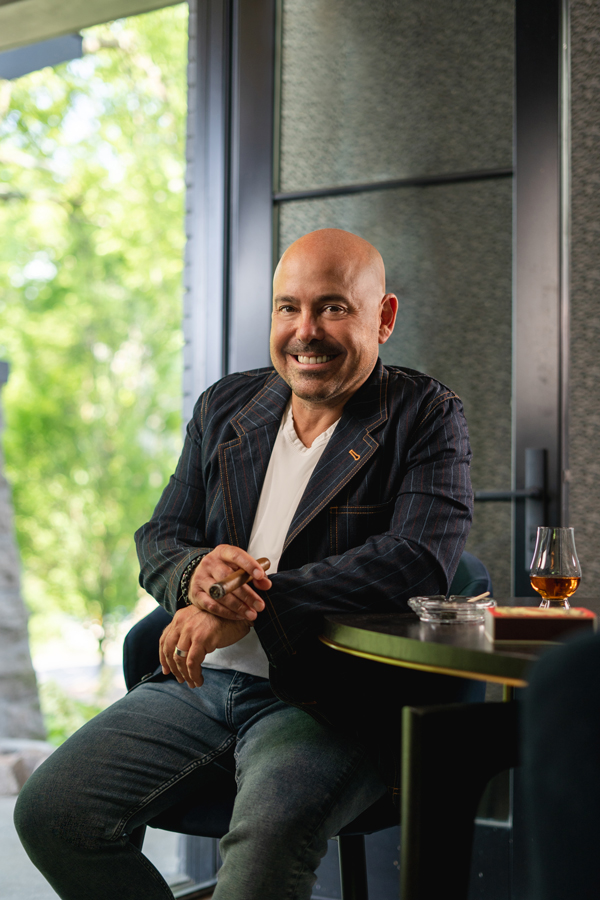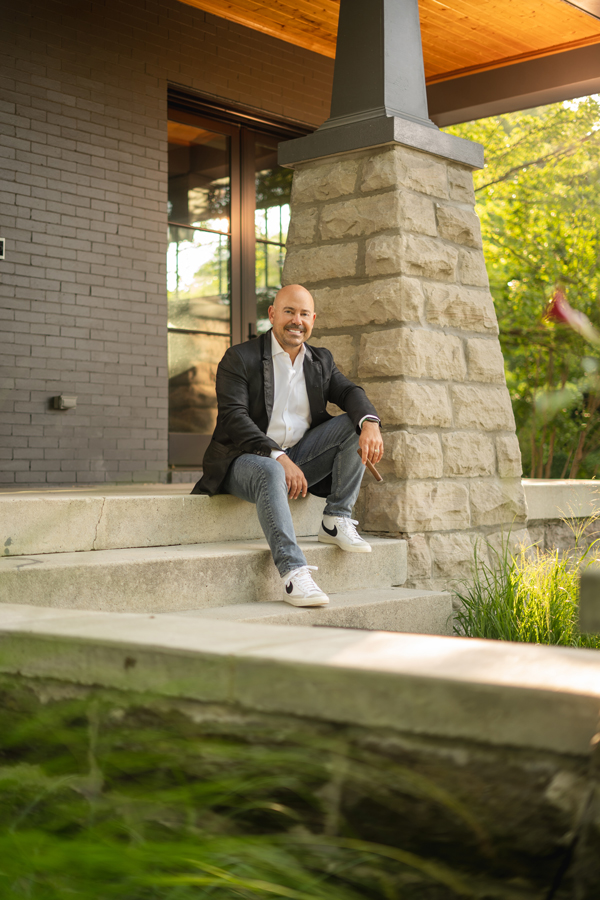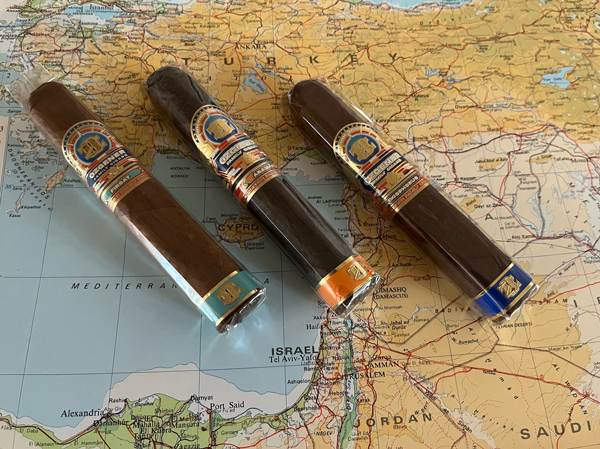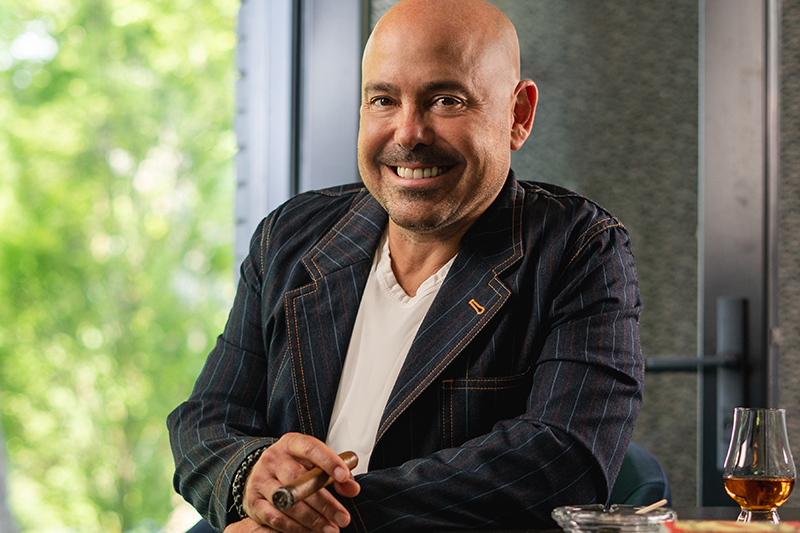How do we gauge success? Is it financial, as in the acquisition of wealth? Is it through relationships such as friendship, marriage and family? Could it be the accomplishment of a long-sought goal? For some, it may be to live a life of purpose, of service to others, to a cause greater than oneself. By all of these measures, OZ Family Cigars owner Tim Ozgener may be deemed successful several times over.
The Ozgener family history is the classic American success story. Tim’s father, Cano Aret Ozgener, was an Armenian Turk whose original family surname had been changed from Armenian to Turkish to escape persecution. An excellent student, Cano was accepted at Columbia University in New York, where he earned a degree in mechanical engineering. While there, he met his future wife Esen, a Turkish native who had earned a Fulbright Scholarship to study in New York’s Bank Street College of Education, across the street from Columbia.

Says Tim: “They met at the International House student dorms, attended various cultural events together and wound up falling in love.” This Romeo and Juliet-style relationship of an unlikely Turkish and Armenian couple falling in love in New York and eventually establishing their careers and raising a family in Nashville, Tennessee, paved the way for the Ozgener family to create one of the U.S. market’s leading brands, initially CAO Pipes, and subsequently CAO Cigars.
While Esen went on to earn her PhD in Early Childhood Education from Vanderbilt University, Cano gained employment as a chemical engineer at DuPont Chemical. Being from Turkey, Cano was fond of smoking meerschaum pipes, and being an engineer and inveterate tinkerer, he decided to improve on the traditional screw-in stem fitting, which would often damage the soft material. By sourcing existing materials, he created the male/female connection now used by all meerschaum pipemakers. A retailer noticed Cano’s invention and wanted to order pipes from him. Never wanting to say no to any opportunity, Cano contacted his brother-in-law in Turkey and together they started having pipes made with their unique stem fit and selling them on the U.S. market. “[Cano] received calls for the pipes with that fitting, and they wanted his initials on the stem to identify his pipes,” says Tim. “He drilled his initials into the shank, later implanting the logo on the stem. That’s how the CAO brand was born.”
So in 1968, pipe importing became a side business for Cano as he was still employed by DuPont. In 1977, Ozgener left Dupont to devote himself to CAO Pipes full-time, working with one or two employees from his home’s basement. He developed a relationship with a gifted carver named Ismet Bekler. Cano recognized that Bekler’s pipes were more artistic than most and encouraged Bekler to sign his pieces, with Bekler becoming the first pipe carver to do so. Demand surged for the “designer” pipes, and Ozgener and Bekler traveled the U.S. doing in-store events.
CAO’s leap into manufacturing cigar humidors came from a trip Cano made to London. Tim says, “Dad was in London when the cigar boom was starting. On Portobello Road he came across a shop selling antique jewelry and letter boxes. He decided to buy them with the intention of converting them to cigar humidors.”
Upon his return to Nashville he found a woodworker who could line the boxes with Spanish cedar. Those dozen or so boxes sold out at the trade show, as did the 20 then 40 pieces at subsequent shows. Realizing that there was a finite amount of antique boxes, Cano asked the woodworkers to construct humidors from solid woods, utilizing oak, cherry, mahogany and walnut.
“That’s how we got into the humidor business,” says Tim. “Dad applied his engineering skills to humidor production, employing piano hinges, mitered corners, and a custom humidification system developed by a chemist friend at Vanderbilt University.”
While Cano was establishing the family business, Tim traveled across the country to study at the University of Southern California. His natural affinity for acting had drawn him to Los Angeles. “I graduated from USC and I was doing a lot of acting gigs, improv comedy, and stand-up comedy at night. And during the day I was visiting a lot of stores.”
The CAO humidors were selling quite well, and Cano saw the logic of expanding into cigars. He had begun looking for a manufacturer, but even those amenable to working with him could hardly produce enough of their own cigars because of the increased demand. An introduction to Nestor Plasencia resulted in the 1994 release of their first cigar line, CAO Black. Two years later they debuted their follow-up label, CAO Gold. They Ozgeners were able to get the cigars into stores thanks to their stellar reputation in the industry, the success of their pipe and humidor lines, and because retailers were eager for cigars to put on their shelves. But the cigars were products of the boom market, subject to the inconsistencies of the time. As Tim remembers: “Neither set the world on fire. So I went around to cigar stores and listened to retailers, and tried the cigars that they recommended.” The search was on to find a cigar that would appeal to product-hungry consumers.
The Ozgeners’ fortunes changed when a mutual friend learned of a quantity of cigars being stored by a manufacturer because his principal customer wasn’t using them at the time. The box-pressed maduros had plenty of aging, and seemed to be exactly what the market was looking for. Thus was born the CAO L’Anniversaire, a game-changing product that took off like a rocket and blew up the market. CAO was finally a nationally recognized brand. By the end of 1999, Tim committed to moving back to Nashville from L.A. to help growth of the CAO Cigars brand. He was soon joined by his sister, Aylin. A graduate of Indiana University, Aylin “had a knack for business, sales and economics, and was recruited by Cano to head up the sales force,” says Tim. An excellent salesperson herself, Aylin utilized phone sales to grow the brand while Tim worked the West Coast. It was a true family affair.
The Ozgeners’ next lesson in overcoming adversity came when the cigar manufacturer supplying their cigars informed them that his main customer did not want him selling cigars to CAO, and that they had six months to find another factory.
Says Tim, “By listening and sampling I had developed more of a palate. I’d ask, ‘What would it take to be successful in your store?’ I built relationships that helped me with product development, including with several cigar makers.”

A friendship with Nick Perdomo led to a visit to his Nicaraguan factory, where Ozgener realized he could not only replicate the L’Anniversaire Maduro blend, but could expand the series using other types of wrappers. The creative efforts of Perdomo and Ozgener led to the debut of the CAO Cameroon in an extreme box-pressed format. The unique blend of Nicaraguan tobacco and Cameroon wrapper, plus the ultra-flat box press, took the market by storm, racking up another CAO success.
Numerous other successes followed, bringing the boutique cigar maker to the attention of Henri Wintermans, the Dutch manufacturer of Cafe Creme cigars. “Cafe Creme was huge,” Tim recalls, “but Wintermans wanted to get into the premium cigar world in the U.S.” Although flattered by the attention, the Ozgeners declined an offer to sell the brand. A year later, Wintermans came back with a more substantial offer, and with S-Chip and other regulatory hurdles on the horizon, CAO was sold in 2007. Cano Ozgener took the opportunity to take a well-deserved retirement, and Tim was offered a five-year contract to stay on as president, with most of the CAO team remaining intact. By 2010, Scandinavian Tobacco Group, who now owned Wintermans, was merging with Swedish Match, and Tim was ready to exit the corporate world. He signed a two-year non-compete clause and resigned.
As Tim contemplated his next venture, Cano had been investigating how performing arts centers were transforming cities like Miami, Brooklyn and downtown Los Angeles. Many of these were in converted warehouses that were previously industrial. Tim realized, “We have a warehouse. Let’s turn this building into a contemporary arts center.”
Their time and efforts resulted in the creation of OZ Arts Nashville, a vibrant center for the performing arts. They applied for nonprofit status in 2012 and their first performance was in 2014. OZ Arts Nashville celebrated its 10th anniversary this year.
Having performed every function, from fundraising to hiring to the design of the performance space, Tim finally hired a seasoned director to take over the bulk of the responsibilities. And while he still helps with fundraising and connecting with sponsors and donors, Tim was free to contemplate his return to the cigar business. Two of his key team members from CAO, Mike Conder and Jon Huber, had declined the offer to join Swedish match and instead remained in Nashville to form their own boutique cigar line, Crowned Heads. After his two-year non-compete clause was satisfied, Tim was able to reconnect with his former colleagues, becoming a silent partner in Crowned Heads. Then he started thinking about his new cigar brand.
Tim first considered what his relationship with his partners should be. He says, “Crowned Heads had their own ethos, and I thought there’s a rich history of my family being in the business and I think people would like this story, so let’s do something to bring the heritage and the history both into play. What do I have about me that makes me different? Ultimately, it’s about all this aggregate experience I have in the business.” Having decided to use the brand to honor his family legacy, Ozgener set out to find the right manufacturer to bring his vision to market.
Rather than return to CAO’s original factory, Ozgener turned to a trusted family friend, Ernesto Perez Carillo, founder and owner of Casa Carillo Cigars. “I have known Ernesto for over 30 years. My dad used to give him pipes for cigars,” says Tim. “So I visited him in Miami, I showed him all the artwork, the iconography of how my mom and dad met. And Ernesto said, ‘This is beautiful, and I’d be honored to make the cigar for you.’ Pretty quickly we moved all the materials to Casa Carillo. And the original blend is the exact same except for one change: Ernesto made the wrapper a Habano 2000 seed grown in Ecuador, as opposed to a Sumatra seed grown there. From a taste standpoint, that was an improvement. Working with Ernesto has been a real pleasure.”
It would be tempting at this point to fall back on the old cliché, “And the rest is history.” Yes, the new line, named Bosphorous for the Turkish strait separating Europe from the Middle East, has been enthusiastically embraced by retailers and consumers alike. But Ozgener was not finished yet. The medium-bodied Bosphorus was followed by the fuller, maduro-wrapped Aramas. As with Bosphorus, the name has personal significance for Ozgener. It is a melding of the Turkish and Armenian names for the fabled Mount Ararat, which is depicted on the cigar’s band. Firsat, the third entry in the trilogy series came about as part of Ozgener’s interactive and collaborative efforts. “I was in the market, doing a lot of events, and I was struck by how many people came to me and said, ‘Do you have something that’s milder?’ So we based the new line on a limited cigar we had named Pi Synesthesia. It was mild to medium, with some complexity, an Ecuador Connecticut wrapper with some milder Nicaraguan fillers. I suggested this to Ernesto who realized if we used a higher priming leaf it would taste richer. That became the Firsat line.”
The name Firsat is derived from the Turkish word meaning opportunity. Once again, the concept was to honor the family’s journey, in this case, realizing their dream to emigrate to America. This is amply represented on the cigar band, featuring an image of the Statue of Liberty.
Oz Family Cigars has established a firm foothold in today’s premium cigar market, with representation throughout the country. Ozgener proudly states, “The Bosphorous line got the highest vertical rating in my family’s history; 92, 93, 92 and 90. Aramas also got a slew of 90+ ratings.”

So what does the future hold for this seasoned entrepreneur and his surging brand? “Ernesto has a lot of ‘one-off’ tobaccos. He might have one bale of tobacco that is 13 years old. I’m talking with him about how we can use some of these tobaccos that are literally aged.” Tim is constantly striving to work with his retail partners and their customers to fine-tune and expand the OZ Family line. His extensive event schedule is an effort to connect with consumers, utilizing his communications skills to inform as well as entertain them. The way he tells it: “With my experience in acting and on the stage I can explain to them, answer questions as best I can and convey it to them in a way they can understand. I like doing that.”
Tim will continue to utilize his broad experience, top quality industry partners, and consumer feedback to extend and improve his already highly successful brand of cigars. He looks forward to welcoming his two sons, Evan and Aidan, into the family business one day. “They both enjoy cigars. They can taste differences in the cigars. They appreciate the hard work that goes into the making of a cigar. At this point they certainly appreciate and enjoy cigar smoking,” he says with obvious pleasure at the thought of the next generation continuing the family legacy. Cano would indeed be proud.
—
For more information regarding OZ Family Cigars visit ozfamilycigars.com.
– Story by Larry Wagner. Photography courtesy of OZ Family Cigars.
This story first appeared in PCA The Magazine, Volume 4, 2024. To receive a copy of this magazine you must be a current member of PCA. Join or renew today at premiumcigars.org/membership.

